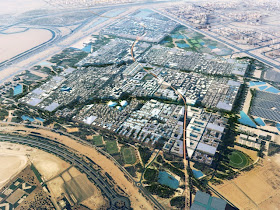[Blueprint for a nature immersed car free city.]
Imagine a city, town or region completely free of cars. Cities without cars are more peaceful, less pollutant by far, have closer social ties and are safer. Some are a reality, some are under construction, some are still a vision, some are quite science fiction. This list is a mixture of them all.
Venice
Perhaps the most famous car free place in the world, a city of canals and boats, home to 70,000 people.
Old City Jerusalem is also a historical anomaly. Home to 35,000 people it does not have any streets big enough for cars to drive on.
Imagine a city, town or region completely free of cars. Cities without cars are more peaceful, less pollutant by far, have closer social ties and are safer. Some are a reality, some are under construction, some are still a vision, some are quite science fiction. This list is a mixture of them all.
Venice
Perhaps the most famous car free place in the world, a city of canals and boats, home to 70,000 people.
Fes-al-Bali
Fes-al-Bali in Morocco is home to 150,000 people, but with a population density of 550 per sq. metre, it is very crowded.
Cheung Chau
An island near Hong Kong city, the majority of the city has streets that are simply too narrow for cars. The city have developed tiny emergency vehicles though. It is home to 23,000 people.
Old City Jerusalem
Iquitos
Iquitos in Peru is not particularly safe for pedestrians, but it is novel and therefore fun to include in the list. It is a city with virtually no cars, but motorbikes instead. This is because it is an isolated city, not connected by road to the outside world.
Masdar
Masdar is a new city under construction. It is located outside of Abu-Dhabi in the Arab Emirates. It will be home to 50,000 people and many clean energy companies. It will be the world's first completely energy clean city running on solar, wind and geothermal energy. At $22 billion, that is a fairly modest price tag for such a modern city. Hopefully it will create a blue print for new cities around the world.
Science fiction lily pad city- Ecopolis
Designed by Belgian architect Vincent Callebaut, the Ecopolis is envisaged for a world plagued by rising sea levels.
Lobe city design
Designed by J.H.Crawford of carfree.com , the lobe city is based upon a concept of multiple districts each with their own metro underground train station. Each district then has a population of up to 12,000 people. All of their daily needs are met within their own district. A city made up of 100 or so districts would have a population of 1 million and take up to 45 minutes to travel across.
Why build a completely new city?
There are plenty of people who would love to live in a car free city. But there are also plenty of people opposed to such an idea. Instead of forcing people to transform old cities to car free ones, why not give people the choice of living in a new city better equipped for the purpose.
What is good or bad about the above cities?
Cities like Venice or Fes-al-Bali, Old City Jerusalem and Cheung Chau are steeped in history and culture and they would be intriguing places to live. Of course they probably have very few vacancies, and a move there requires learning a new language and culture.
A city like Iquitos would be unique and less congested than a car based city, but dangerous none the less with mopeds and motor bikes zipping everywhere.
Masdar is the most exciting prospect of the present day because it is a reality. I would be very intrigued to visit there once it is completed and see how it works. One thing Masdar is seriously lacking is nature. It is very concrete based in its environment. They however have worked very hard to make it aesthetically pleasing and the many fountains will surely make it a pleasant place.
The lily pad Ecopolis is novel and science-fictitious. I personally hope that such cities are never necessary, but having said that if people want to live on a lily-pad city it would certainly be very different. It would also be lacking in trees and birds.
The lobe design with multiple districts is a well thought out one. I might design a city differently none the less, but I think it is very likely to work. I would love to see somebody try it.
Another alternative?
There are as many alternatives as there are creative people in the world. My alternative though is a city based upon the idea of buildings and houses being merged with nature as much as possible. This would give the feel of living in a National Park, yet still have all the comforts of a modern city including the Arts and Sports.
My blue print for such a city is here.
A location for such a city?
There are many possible locations, but one such location is particularly appealing from an Australian context. French Island in Western Port Bay is already a car free zone. Seventy people live there and two thirds of the island is National Park. It has a rich Koala population that regularly exports Koalas to the mainland to keep the local population in check.
An ecologically friendly city could be built here that would not interrupt the flora or fauna at all. A high speed railway could be built from the island to the near by city of Melbourne, giving the residents of French Island access to the culture of a big city. The goal would still be to attract tertiary industry to the island so that residents could be employed there and have their community life there.











No comments:
Post a Comment